2011 CHEVROLET HHR seats
[x] Cancel search: seatsPage 65 of 430
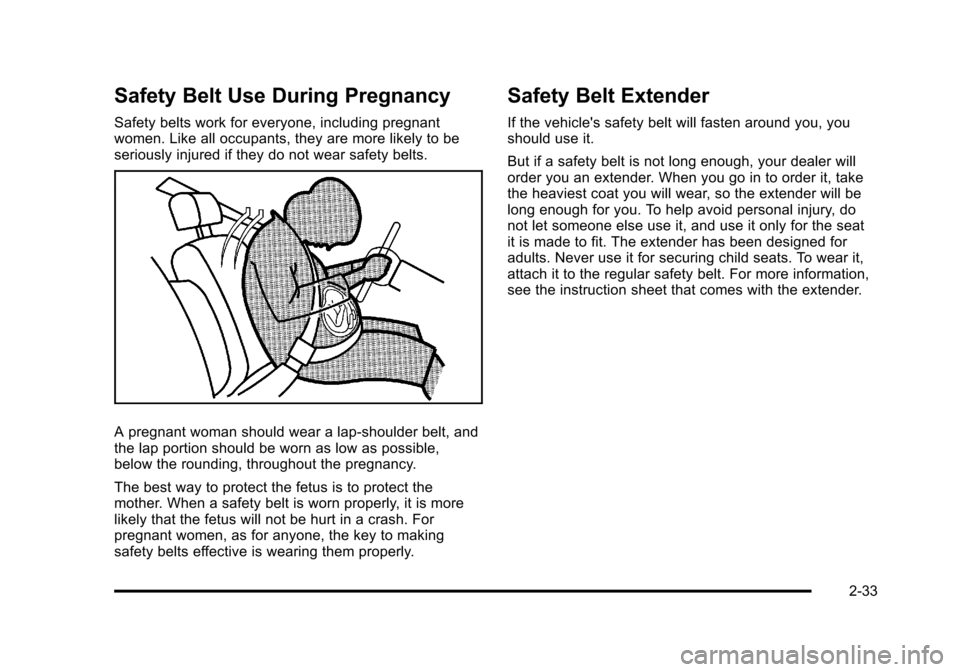
Black plate (33,1)Chevrolet HHR Owner Manual - 2011
Safety Belt Use During Pregnancy
Safety belts work for everyone, including pregnant
women. Like all occupants, they are more likely to be
seriously injured if they do not wear safety belts.
A pregnant woman should wear a lap-shoulder belt, and
the lap portion should be worn as low as possible,
below the rounding, throughout the pregnancy.
The best way to protect the fetus is to protect the
mother. When a safety belt is worn properly, it is more
likely that the fetus will not be hurt in a crash. For
pregnant women, as for anyone, the key to making
safety belts effective is wearing them properly.
Safety Belt Extender
If the vehicle's safety belt will fasten around you, you
should use it.
But if a safety belt is not long enough, your dealer will
order you an extender. When you go in to order it, take
the heaviest coat you will wear, so the extender will be
long enough for you. To help avoid personal injury, do
not let someone else use it, and use it only for the seat
it is made to fit. The extender has been designed for
adults. Never use it for securing child seats. To wear it,
attach it to the regular safety belt. For more information,
see the instruction sheet that comes with the extender.
2-33
Page 66 of 430
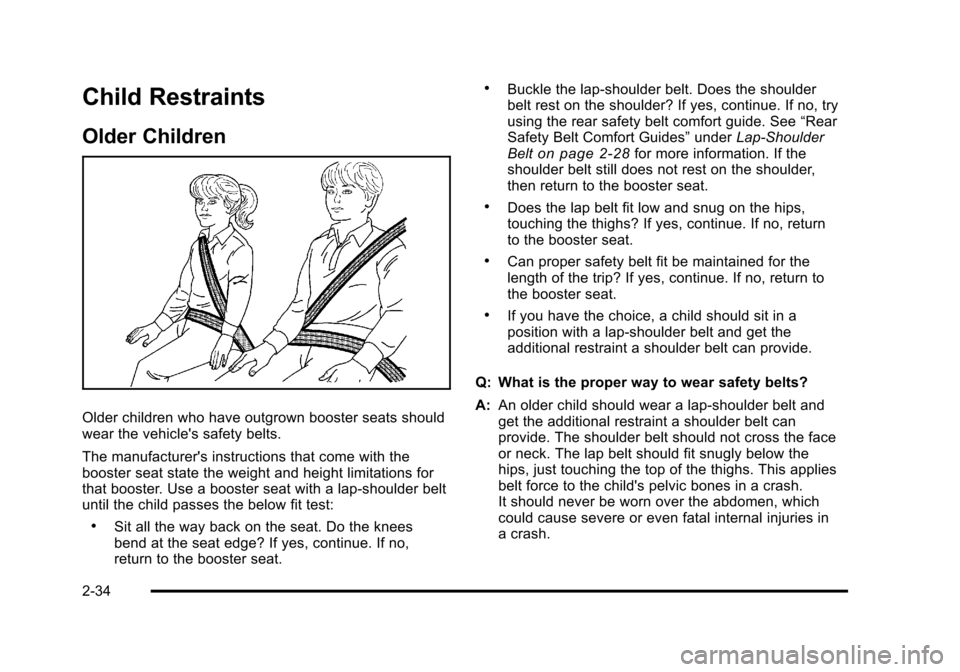
Black plate (34,1)Chevrolet HHR Owner Manual - 2011
Child Restraints
Older Children
Older children who have outgrown booster seats should
wear the vehicle's safety belts.
The manufacturer's instructions that come with the
booster seat state the weight and height limitations for
that booster. Use a booster seat with a lap-shoulder belt
until the child passes the below fit test:
.Sit all the way back on the seat. Do the knees
bend at the seat edge? If yes, continue. If no,
return to the booster seat.
.Buckle the lap-shoulder belt. Does the shoulder
belt rest on the shoulder? If yes, continue. If no, try
using the rear safety belt comfort guide. See“Rear
Safety Belt Comfort Guides” underLap-Shoulder
Belt
on page 2‑28for more information. If the
shoulder belt still does not rest on the shoulder,
then return to the booster seat.
.Does the lap belt fit low and snug on the hips,
touching the thighs? If yes, continue. If no, return
to the booster seat.
.Can proper safety belt fit be maintained for the
length of the trip? If yes, continue. If no, return to
the booster seat.
.If you have the choice, a child should sit in a
position with a lap-shoulder belt and get the
additional restraint a shoulder belt can provide.
Q: What is the proper way to wear safety belts?
A: An older child should wear a lap-shoulder belt and
get the additional restraint a shoulder belt can
provide. The shoulder belt should not cross the face
or neck. The lap belt should fit snugly below the
hips, just touching the top of the thighs. This applies
belt force to the child's pelvic bones in a crash.
It should never be worn over the abdomen, which
could cause severe or even fatal internal injuries in
a crash.
2-34
Page 73 of 430
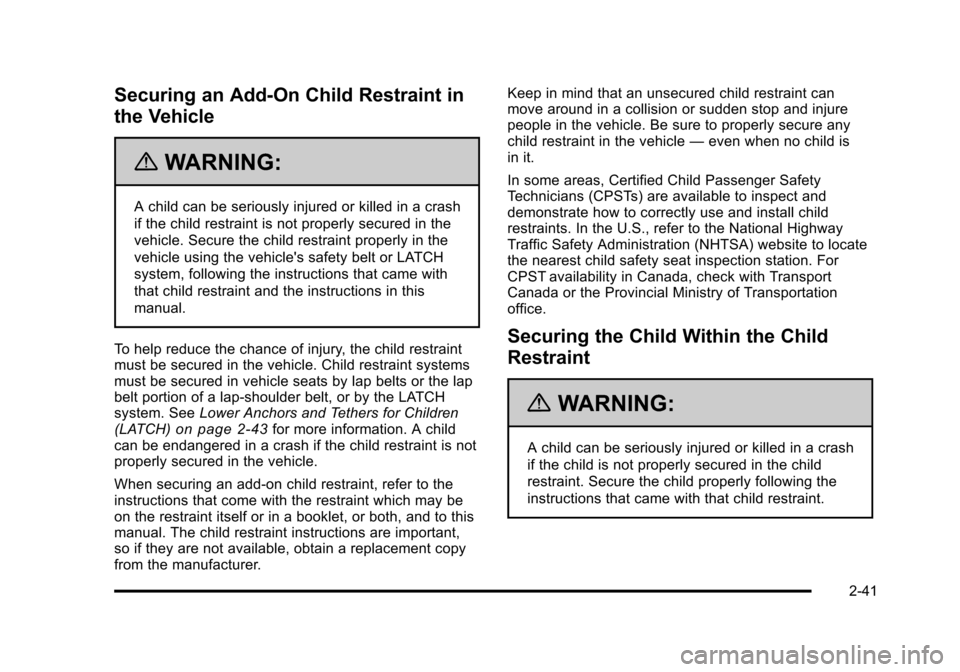
Black plate (41,1)Chevrolet HHR Owner Manual - 2011
Securing an Add-On Child Restraint in
the Vehicle
{WARNING:
A child can be seriously injured or killed in a crash
if the child restraint is not properly secured in the
vehicle. Secure the child restraint properly in the
vehicle using the vehicle's safety belt or LATCH
system, following the instructions that came with
that child restraint and the instructions in this
manual.
To help reduce the chance of injury, the child restraint
must be secured in the vehicle. Child restraint systems
must be secured in vehicle seats by lap belts or the lap
belt portion of a lap-shoulder belt, or by the LATCH
system. See Lower Anchors and Tethers for Children
(LATCH)
on page 2‑43for more information. A child
can be endangered in a crash if the child restraint is not
properly secured in the vehicle.
When securing an add-on child restraint, refer to the
instructions that come with the restraint which may be
on the restraint itself or in a booklet, or both, and to this
manual. The child restraint instructions are important,
so if they are not available, obtain a replacement copy
from the manufacturer. Keep in mind that an unsecured child restraint can
move around in a collision or sudden stop and injure
people in the vehicle. Be sure to properly secure any
child restraint in the vehicle
—even when no child is
in it.
In some areas, Certified Child Passenger Safety
Technicians (CPSTs) are available to inspect and
demonstrate how to correctly use and install child
restraints. In the U.S., refer to the National Highway
Traffic Safety Administration (NHTSA) website to locate
the nearest child safety seat inspection station. For
CPST availability in Canada, check with Transport
Canada or the Provincial Ministry of Transportation
office.
Securing the Child Within the Child
Restraint
{WARNING:
A child can be seriously injured or killed in a crash
if the child is not properly secured in the child
restraint. Secure the child properly following the
instructions that came with that child restraint.
2-41
Page 75 of 430
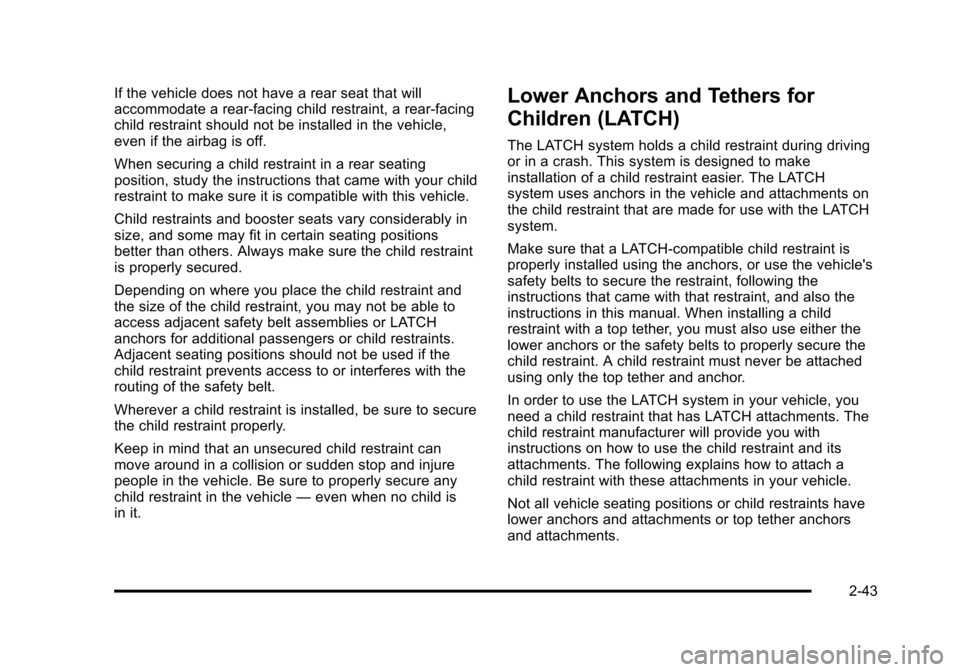
Black plate (43,1)Chevrolet HHR Owner Manual - 2011
If the vehicle does not have a rear seat that will
accommodate a rear-facing child restraint, a rear-facing
child restraint should not be installed in the vehicle,
even if the airbag is off.
When securing a child restraint in a rear seating
position, study the instructions that came with your child
restraint to make sure it is compatible with this vehicle.
Child restraints and booster seats vary considerably in
size, and some may fit in certain seating positions
better than others. Always make sure the child restraint
is properly secured.
Depending on where you place the child restraint and
the size of the child restraint, you may not be able to
access adjacent safety belt assemblies or LATCH
anchors for additional passengers or child restraints.
Adjacent seating positions should not be used if the
child restraint prevents access to or interferes with the
routing of the safety belt.
Wherever a child restraint is installed, be sure to secure
the child restraint properly.
Keep in mind that an unsecured child restraint can
move around in a collision or sudden stop and injure
people in the vehicle. Be sure to properly secure any
child restraint in the vehicle—even when no child is
in it.Lower Anchors and Tethers for
Children (LATCH)
The LATCH system holds a child restraint during driving
or in a crash. This system is designed to make
installation of a child restraint easier. The LATCH
system uses anchors in the vehicle and attachments on
the child restraint that are made for use with the LATCH
system.
Make sure that a LATCH-compatible child restraint is
properly installed using the anchors, or use the vehicle's
safety belts to secure the restraint, following the
instructions that came with that restraint, and also the
instructions in this manual. When installing a child
restraint with a top tether, you must also use either the
lower anchors or the safety belts to properly secure the
child restraint. A child restraint must never be attached
using only the top tether and anchor.
In order to use the LATCH system in your vehicle, you
need a child restraint that has LATCH attachments. The
child restraint manufacturer will provide you with
instructions on how to use the child restraint and its
attachments. The following explains how to attach a
child restraint with these attachments in your vehicle.
Not all vehicle seating positions or child restraints have
lower anchors and attachments or top tether anchors
and attachments.
2-43
Page 78 of 430
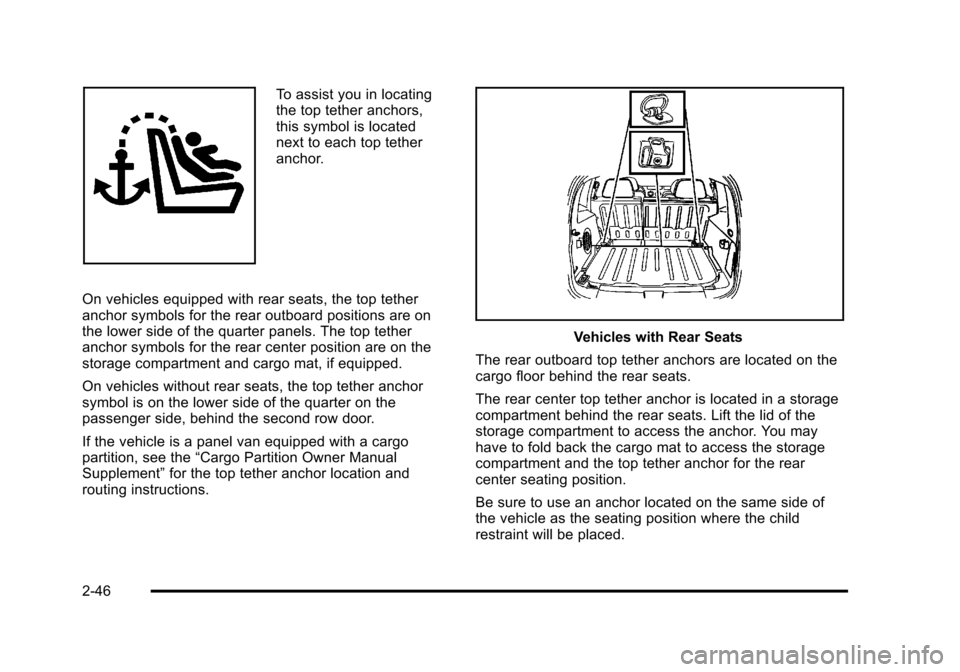
Black plate (46,1)Chevrolet HHR Owner Manual - 2011
To assist you in locating
the top tether anchors,
this symbol is located
next to each top tether
anchor.
On vehicles equipped with rear seats, the top tether
anchor symbols for the rear outboard positions are on
the lower side of the quarter panels. The top tether
anchor symbols for the rear center position are on the
storage compartment and cargo mat, if equipped.
On vehicles without rear seats, the top tether anchor
symbol is on the lower side of the quarter on the
passenger side, behind the second row door.
If the vehicle is a panel van equipped with a cargo
partition, see the “Cargo Partition Owner Manual
Supplement” for the top tether anchor location and
routing instructions.
Vehicles with Rear Seats
The rear outboard top tether anchors are located on the
cargo floor behind the rear seats.
The rear center top tether anchor is located in a storage
compartment behind the rear seats. Lift the lid of the
storage compartment to access the anchor. You may
have to fold back the cargo mat to access the storage
compartment and the top tether anchor for the rear
center seating position.
Be sure to use an anchor located on the same side of
the vehicle as the seating position where the child
restraint will be placed.
2-46
Page 79 of 430
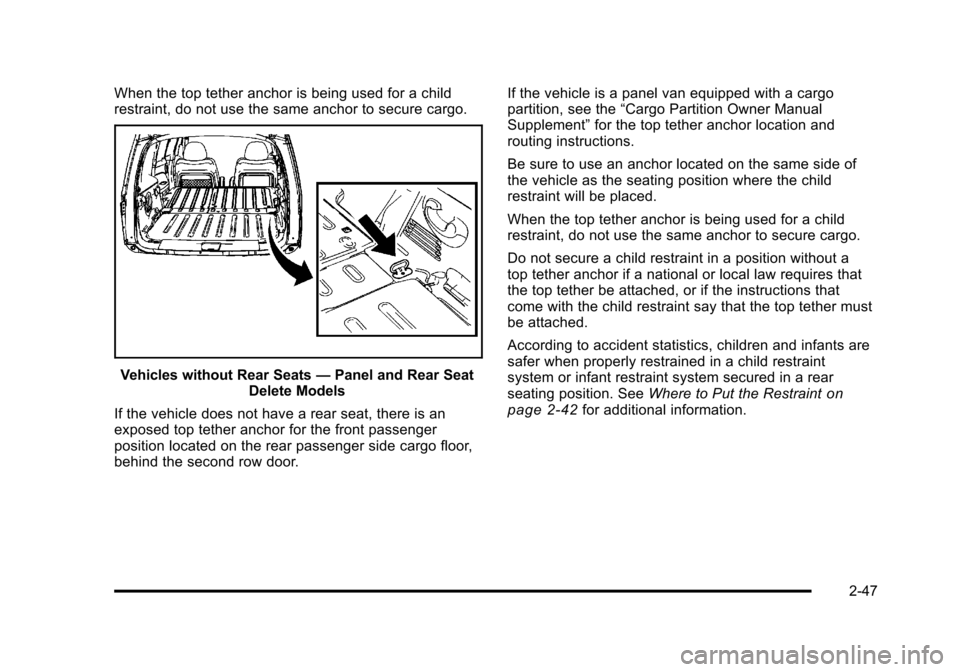
Black plate (47,1)Chevrolet HHR Owner Manual - 2011
When the top tether anchor is being used for a child
restraint, do not use the same anchor to secure cargo.
Vehicles without Rear Seats—Panel and Rear Seat
Delete Models
If the vehicle does not have a rear seat, there is an
exposed top tether anchor for the front passenger
position located on the rear passenger side cargo floor,
behind the second row door. If the vehicle is a panel van equipped with a cargo
partition, see the
“Cargo Partition Owner Manual
Supplement” for the top tether anchor location and
routing instructions.
Be sure to use an anchor located on the same side of
the vehicle as the seating position where the child
restraint will be placed.
When the top tether anchor is being used for a child
restraint, do not use the same anchor to secure cargo.
Do not secure a child restraint in a position without a
top tether anchor if a national or local law requires that
the top tether be attached, or if the instructions that
come with the child restraint say that the top tether must
be attached.
According to accident statistics, children and infants are
safer when properly restrained in a child restraint
system or infant restraint system secured in a rear
seating position. See Where to Put the Restraint
on
page 2‑42for additional information.
2-47
Page 81 of 430
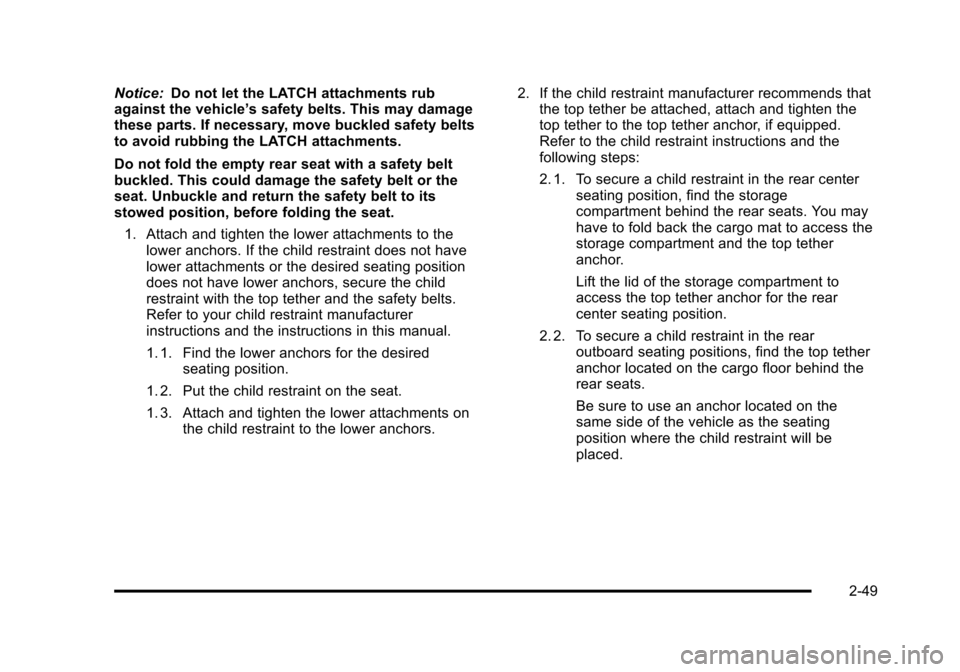
Black plate (49,1)Chevrolet HHR Owner Manual - 2011
Notice:Do not let the LATCH attachments rub
against the vehicle’ s safety belts. This may damage
these parts. If necessary, move buckled safety belts
to avoid rubbing the LATCH attachments.
Do not fold the empty rear seat with a safety belt
buckled. This could damage the safety belt or the
seat. Unbuckle and return the safety belt to its
stowed position, before folding the seat.
1. Attach and tighten the lower attachments to the lower anchors. If the child restraint does not have
lower attachments or the desired seating position
does not have lower anchors, secure the child
restraint with the top tether and the safety belts.
Refer to your child restraint manufacturer
instructions and the instructions in this manual.
1. 1. Find the lower anchors for the desired seating position.
1. 2. Put the child restraint on the seat.
1. 3. Attach and tighten the lower attachments on the child restraint to the lower anchors. 2. If the child restraint manufacturer recommends that
the top tether be attached, attach and tighten the
top tether to the top tether anchor, if equipped.
Refer to the child restraint instructions and the
following steps:
2. 1. To secure a child restraint in the rear center
seating position, find the storage
compartment behind the rear seats. You may
have to fold back the cargo mat to access the
storage compartment and the top tether
anchor.
Lift the lid of the storage compartment to
access the top tether anchor for the rear
center seating position.
2. 2. To secure a child restraint in the rear outboard seating positions, find the top tether
anchor located on the cargo floor behind the
rear seats.
Be sure to use an anchor located on the
same side of the vehicle as the seating
position where the child restraint will be
placed.
2-49
Page 82 of 430
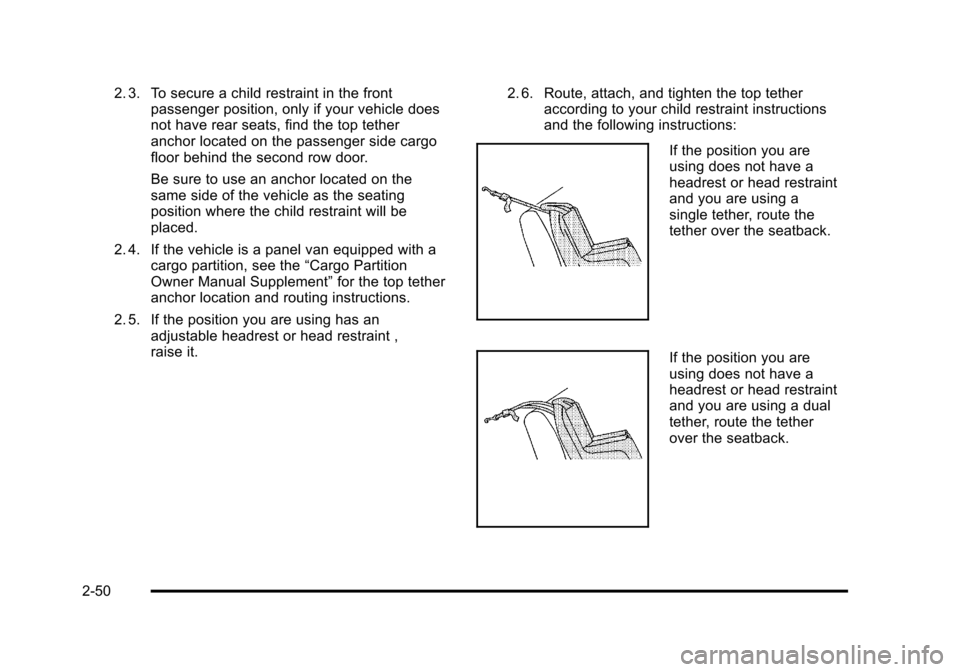
Black plate (50,1)Chevrolet HHR Owner Manual - 2011
2. 3. To secure a child restraint in the frontpassenger position, only if your vehicle does
not have rear seats, find the top tether
anchor located on the passenger side cargo
floor behind the second row door.
Be sure to use an anchor located on the
same side of the vehicle as the seating
position where the child restraint will be
placed.
2. 4. If the vehicle is a panel van equipped with a cargo partition, see the “Cargo Partition
Owner Manual Supplement” for the top tether
anchor location and routing instructions.
2. 5. If the position you are using has an adjustable headrest or head restraint ,
raise it. 2. 6. Route, attach, and tighten the top tether
according to your child restraint instructions
and the following instructions:
If the position you are
using does not have a
headrest or head restraint
and you are using a
single tether, route the
tether over the seatback.
If the position you are
using does not have a
headrest or head restraint
and you are using a dual
tether, route the tether
over the seatback.
2-50